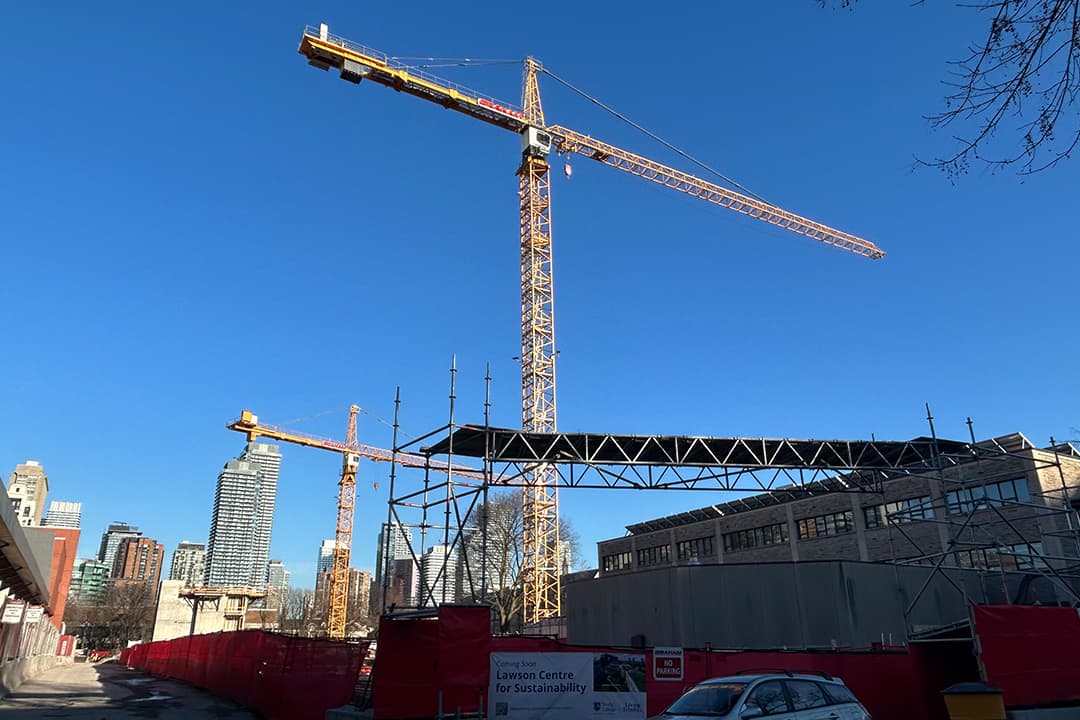U of T prides itself on its abundance of green spaces, especially considering it’s nestled in the heart of Canada’s largest city. After all, everyone loves green spaces. Sprawling fields of grass, tall trees to sit under, and gardens of diverse, native, pollinator-friendly flowers are cornerstones of a North American university campus.
So, it’s not exactly a surprise when students react to the loss of a large, open green space for development. Last November, a Reddit post hit the front page of r/UofT with almost 200 upvotes and generated a storm of controversy. The post highlighted the current construction work on Trinity College’s Lawson Centre for Sustainability, a new addition to Trinity that would include residences, classrooms, and other community facilities. The Centre, expected to be completed in 2025, is being built on a plot of land north of Trinity and south of Varsity Field — a sizable and underutilized grassy patch on the Trinity campus.
“Destroying one of the only green spaces on campus to build a sustainability centre,” wrote the poster. “U of T math,” they titled it, highlighting the apparent backward logic in demolishing a natural area for yet another urban project. On the face of it, their argument is logical. But beneath the surface, this whole dialogue reflects a very real problem with the public’s understanding of “sustainability.”
Using Toronto’s land
Toronto’s population is skyrocketing, and the value of land on and near the St. George campus has been growing with it. Last October, the Toronto Star reported that real estate prices have almost doubled across the entire GTA since 2010.
Combined with U of T’s enrolment increasing by approximately 16 per cent in the last decade, the high real estate prices mean that the market for student housing is far more competitive than it used to be. High demand and low supply means more students are living further away from campus, with many of them forced to commute by public transit or their own personal vehicles.
Hence, the Lawson Centre: a solar-powered classroom and residence building constructed from timber, with rainwater collection, high-tech insulation, and a rooftop garden for on-campus food production. The university needs to address the problem of affordable student housing. Building a large, well-designed building with accommodation for hundreds of students definitely seems like a step in the right direction.
Increasing the on-campus housing supply can also make U of T more sustainable. 2021 research from the German Hot or Cool Institute has shown that 35 per cent of the average Canadian’s carbon footprint in 2019 was from transportation. A 2019 survey from StudentMoveTO shows that, of all students in Toronto, about one fifth drive, and almost two thirds take either local or regional transit to and from campus. More student housing could mean fewer students driving or cramming onto GO Transit and the TTC.
However, none of this addresses the actual issue being raised: new developments like the Lawson Centre can sometimes mean the loss of green areas on campus.
Trade-offs in sustainability
The field to the north of Trinity was an occasional recreational space before work on the Lawson Centre began, though it was seldom available to students, and was closed off by a fence. The space was hardly the communal outdoor commons that Front Campus or Queen’s Park are today.
When it comes to making a better campus, it’s incorrect to equate spaces like the Trinity field to unequivocal good. For example, the grass required maintenance in the form of lawn mowing, making it a significant investment for something the community hardly made use of. Land, like all resources, is precious, and the university can no longer afford to waste it.
Using a gasoline-powered lawn mower for an hour emits as much air pollution as driving a car for 72 kilometres, in the form of carbon dioxide, nitrogen oxides, and fine particulate matter. According to the US Environmental Protection Agency, garden and lawn equipment engines produce up to five per cent of the country’s air pollution.
There will be trade-offs in the ongoing effort to make our campus and our lives more sustainable. For a handful of Trinity students and athletes, the loss of this green space is disappointing. But when the consolation is a new, environmentally-friendly building with more student housing, such a trade-off will probably be worth it in the long run.



No comments to display.